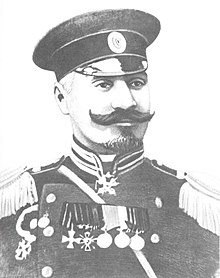Aliagha Shikhlinski
Ali-Agha Ismail-Agha oglu Shikhlinski | |
|---|---|
 Ali-Agha Shikhlinski | |
| Born | April 23, 1865 Kazakh |
| Died | August 18, 1943 (aged 78) Baku |
| Allegiance | Imperial Russian Army, Azerbaijan Democratic Republic, USSR |
| Years of service | 1886—1929 |
| Rank | Lieutenant-general, General of the Artillery |
| Battles / wars | Russo-Japanese War, World War I |
| Awards | Order of Saint George 4th degree |
Ali-Agha Ismail-Agha oglu Shikhlinski (Template:Lang-az, Template:Lang-ru; April 23, 1865 — 18 August 1943) was lieutenant-general of the Russian imperial army and Deputy Minister of Defense and General of the Artillery of Azerbaijan Democratic Republic.
Life and military career
Ali-Agha Shikhlinski was born on April, 23, in the village of Kazakhly of Kazakh uyezd. He descended from an old noble family first mention which relates in 1537. His mother Shah Yemen Khanum was a grandchild of a famous poet Molla Vali Vidadi. In August 1876 he entered Tiflis military school and graduated in 1883. He then finished Mikhaylovsky Artillery School in Saint Petersburg in 1886, received the rank of podporuchik and was assigned to 39th artillery brigade, located in Alexandropol. In the course of military service he was promoted to poruchik, then shtabs-kapitan and appointed as commander of the training team. In 1900, Captain Shikhlinski was transferred to Transbaikal artillery battalion. He took part in China Relief Expedition of the Russian army.
During the Russo-Japanese War Shikhlinski was the commander of an artillery battery. He especially distinguished himself during the siege of Port Arthur when, despite being severely wounded in his leg, he personally aimed the guns which lost their guncrews and repulsed attacks of superior Japanese forces. For the services in battle on September 28, 1905, he was decorated with the Order of Saint George 4th degree. He was also awarded a golden sword and conferred the rank of lieutenant-colonel.
In January 1906, Shikhlinski was seconded to Tsarskoye Selo Officer's Artillery College, which he finished with honors in August of the same year and was appointed the instructor of the Artillery College. During his service as the instructor of the college Shikhlinski published a number of works on artillery, including a book titled “Use of Field Artillery in a Battle”, and invented an original target-finding device, which was called “Shiklinski triangle”. In 1908 Shiklinski was promoted to the rank of colonel, and in 1912 he was conferred the rank of major-general and assigned the deputy chief of Officer's Artillery College.
World War I
When World War I started in 1914 Ali-Agha Shikhlinski was appointed the commander of St. Petersburg garrison artillery. In January 1915 Shikhlinski was seconded to the Northwestern front to manage the training of heavy artillery guncrews. On May 23, 1915, he was appointed the general for errands at the commander-in-chief of the Northwestern front, and after division of the front into two held the same position at the Western front. On October 31, 1915 he was appointed to the position of the general for errands at the Supreme Commander-in-Chief. He was charged with creation of heavy artillery battalions and brigades. From April 1916 16, Shikhlinski was the acting inspector of Western Front artillery. He was in charge of the artillery aspects of operations of the Western Front. On April 2, 1917 Ali-Agha Shikhlinski was promoted to the rank of lieutenant-general.
Later years
After the February Revolution in Russia, Ali-Agha Shikhlinski was appointed the commander of the 10th Russian army in September 1917. After the October revolution, he resigned from his position and moved to Tiflis, where he was charged with formation of the Muslim (Azerbaijani) corps. The corps supported the Ottoman Army of Islam in the Battle of Baku with Bolshevik and British forces. In January 1919, the government of Azerbaijan Democratic Republic appointed Shikhlinski a deputy to the Minister of Defense of Azerbaijan Republic Samedbey Mehmandarov. On June 28, 1919, Ali-Agha Shikhlinski was promoted to the rank of General of the Artillery of the Azerbaijani army. After the Red Army invasion of Azerbaijan and establishment of the Soviet regime in Azerbaijan in April 1920, Shikhlinski was arrested and released two months later.
In 1920–1921, he was seconded to Moscow, where he was an adviser to the artillery inspection department of Red Army and taught in Higher Artillery School. On 18 July 1921, Shikhlinski was transferred back to Baku, where he taught at a military school and became a deputy to the chairman of the military science society of Baku garrison. In 1926, Shikhlinsky published the Russian-Azerbaijani Concise Military Dictionary. He resigned from military service in 1929 and wrote his memoirs, which were published in 1944.
Ali-Agha Shikhlinski died in Baku on 18 August 1943.
External links
- 1865 births
- People from Qazakh
- Imperial Russian Army generals
- Russian military personnel of the Russo-Japanese War
- Russian military personnel of World War I
- Azerbaijani people of World War I
- Generals of the Azerbaijan Democratic Republic
- Recipients of the Order of Saint Stanislaus (Russian)
- Azerbaijani nobility
- 1943 deaths
